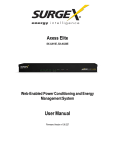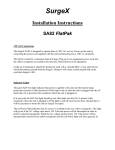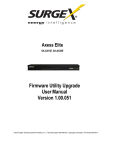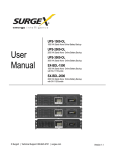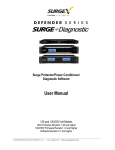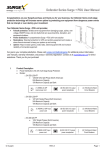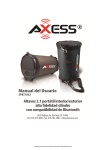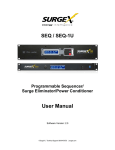Download User Manual
Transcript
Axess Elite SX-AX15E, SX-AX20E Web-Enabled Power Conditioning and Energy Management System User Manual Firmware Version v2.04.281 © 2015 SurgeX / Electronic Systems Protection, Inc. | Technical Support: 800-645-9721 | surgex.com | UM-Axess Elite-Rev B [email protected] | [SCHOOL] User Manual Firmware Version v2.04.281 © 2015 SurgeX/Electronic Systems Protection, Inc. | Technical Support: 800-645-9721 | surgex.com 2 User Manual Firmware Version v2.04.281 Table of Contents 1. Introduction 5 2. Initial Set Up 6 3. Installation 3.1 120 Volt Connections 3.2 Ethernet Connections 3.3 RS232 (Serial) Port Connection 3.4 Temperature Sensor 3.5 Contact Closure Input 3.6 Auxilary Relay Outputs 7 7 7 7 8 8 8 4. LED Indicators 8 5. Web Server 5.1 Login 5.2 Administration 5.2.1 Reset Factory Defaults 5.2.2 Backup/Restore 5.2.3 System Info 5.3 Device View 5.4 Global View 5.5 Setup 5.5.1 Device Setup 5.5.2 Network Setup 5.5.3 Network Reporting Setup 5.5.4 Users Setup 5.5.5 Triggers Setup 5.5.6 User Defined Triggers 5.5.7 Sequences Setup 5.5.8 Links Setup 9 9 9 9 9 9 10 11 11 12 13 15 16 17 18 19 20 6. Command Line Interface (CLI) Protocol 6.1 Prompts 6.2 Syntax 6.3 Responses 6.4 CLI Documentation Notation 6.5 Device Commands 6.6 Network Commands 6.7 Calibration Commands 21 21 21 21 21 22 23 23 © 2015 SurgeX/Electronic Systems Protection, Inc. | Technical Support: 800-645-9721 | surgex.com 3 User Manual Firmware Version v2.04.281 7. Email Notification 24 8 SNMP 24 9. SDxP Protocol 9.1 Overview 9.2 Hello Handshake 9.3 SDxP Packet 9.4 Types 9.5 Descriptors 9.6 Payloads 25 25 25 26 27 27 30 10. Device Management Utility 32 11. Syslog 33 12. Rear Panel Reset Button 33 13 34 Firmware Upgrade 13. Specifications © 2015 SurgeX/Electronic Systems Protection, Inc. | Technical Support: 800-645-9721 | surgex.com 35 4 User Manual Firmware Version v2.04.281 1. Introduction The SurgeX® Axess Elite is a single rack-space, 120V, 15 (20) amp, AC power conditioner that can be controlled over a network or the internet, through a direct serial connection, or through a contact closure input. The simple web server structure allows basic control of the outlets and viewing of status information all from the home page. The extensive programming and setup capabilities are accessed in seven other pages or through a Command Line Interface (CLI). The Axess Elite incorporates SurgeX Advanced Series Mode® power conditioning and surge elimination, SurgeX Impedance Tolerant® EMI/RFI filtering, and SurgeX ICE® Inrush Current Elimination circuitry (on receptacles 1 and 2). SurgeX ICE eliminates problems associated with inrush currents from large loads such as amplifiers. With SurgeX ICE, it is not necessary to take inrush currents into account when designing the AC power for a system. Special time-delay circuit breakers are not required – it is necessary only to ensure that the average currents of all products plugged into the Axess Elite are within the 15 (20) Amp product rating. Telnet and serial access use the same Command Line Interface (CLI) structure and syntax to configure, monitor, and control the Axess Elite. The Axess Elite may also be monitored and controlled via SNMP and/or the SDxP API, and may be configured to report to a Syslog server. The internal web server may be secured with Secure Sockets Layer (SSL) encryption. Two Auxiliary Relay outputs are provided for simple control of other equipment. Connection terminals are provided for each relay’s Common, Normally Open, and Normally Closed connections. Up to 16 Axess Elites can be linked together and controlled from a single web interface. One master Axess Elite provides the communication to the users and receives status information from the rest of the Axess Elites in the cluster. Up to 128 outlets can be controlled in this manner from one IP address. Up to 16 users can be assigned administrator or user only rights, plus access to specific outlets. The extensive programming capabilities of the Axess Elite allow sequencing and scheduling to be set up. User Triggers can be programmed to activate on an “if X then do Y then do Z when no longer X” basis. Triggers include: AC line voltage, total unit current draw, individual receptacle current draw, temperature, Net Test, and Contact Closure Input. Actions include: turning receptacles on and off, cycling a receptacle, executing previously-defined sequences, and sending emails. For example, an action can be created to send an email if the rack temperature exceeds 95oF. The eight rear-mounted receptacles can each be individually controlled, and the current, power, and energy consumption of each receptacle can be obtained through the web page interface and CLI. The metering includes the AC line voltage and current draw, and all measurements (voltage, current and power) are true RMS readings. Thus, the current draw and energy consumption of non-linear electronic loads which have a power factor of less than unity will be correctly reported. Located on the rear panel are the input power cord, circuit breaker (15A or 20A), 8 NEMA 5-15 AC outlets, Serial connection (DCE, 9 pin D-subminiature), Network connection (RJ-45), Temperature Sensor input, Contact Closure input, Auxiliary Relay A/B output connections, and recessed Reset button. Temperature Sensor Red Black Contact Closure CC1 CC2 Auxiliary Relay A NO COM NC © 2015 SurgeX/Electronic Systems Protection, Inc. | Technical Support: 800-645-9721 | surgex.com Auxiliary Relay B NO COM NC 5 User Manual Firmware Version v2.04.281 The thirteen front panel LEDs provide indications for eight AC outlet On/Off status (green), two Auxiliary Relay Latched/Unlatched status (green), surge protection status (green), Shutdown status (amber), and AC mains power (red). 1 2. 2 3 4 5 6 7 8 A B Self-Test Shutdown Mains Initial Set Up *Default user name and password: admin / admin DHCP *Beginning with firmware version 2.04.281, the factory default IP Mode will be DHCP (previously Static). A DHCP Server will automatically assign an IP address (dynamic address) as well as Subnet Mask and Gateway to the Axess Elite. To find the IP address of the Axess Elite, you will need to use the Discover function of the DMU, query your DHCP server and locate the MAC address of the Axess Elite in the DHCP server’s IP/MAC table, or access the CLI via serial and use the get network command. Command Line Interface (CLI) Many configuration parameters may be set using the Command Line Interface (CLI). The CLI is accessed through the network using a telnet client, or through the serial port. Open a telnet client and point it to the current IP Address of the Axess Elite. The factory default telnet port is 23. Connect to the serial port. The factory default settings are 9600, 8, n, 1. Upon connection, press Enter and then enter the user name and password when prompted. The factory default user name and password is admin / admin. These are the basic commands to set the network parameters via CLI. After setting these parameters, the Axess Elite will need to be rebooted for the settings to take effect. Any command that requires rebooting of the Axess Elite will provide a prompt to do so. All commands may be entered as required before rebooting. © 2015 SurgeX/Electronic Systems Protection, Inc. | Technical Support: 800-645-9721 | surgex.com 6 User Manual Firmware Version v2.04.281 Example: Telnet to DHCP-Assigned IP Address 192.168.1.199 on Port 23 and change to Static IP Address 192.168.1.3. Axess ELITE Connected to Telnet Session 1 User> admin Password> ***** Axess ELITE> set ipmode static OK Axess ELITE Reboot Required > set ipaddress 192.168.1.3 OK Axess ELITE Reboot Required> set subnet 255.255.255.0 OK Axess ELITE Reboot Required> set gateway 192.168.1.7 OK Axess ELITE Reboot Required> reboot 3. Installation The SurgeX Axess Elite is designed to be installed in a 19 inch equipment rack and requires one unit (1-U) of rack space. Use the four screws provided with the product to secure the rack ears to the rack rails. These screws can be tightened by hand and do not require tools. Connect power to the unit by plugging the cord into a 120V AC, 15 (20) amp wall or floor receptacle. Do not plug the unit into a relocatable power tap. 3.1 120 Volt Connections The Axess Elite has a total of 8 receptacles. Each receptacle is rated for a maximum load of 15 amps, but the total load of the Axess Elite must not exceed 15 (20) amps. Plug the equipment cords into the receptacles as needed. The receptacles are numbered 1 through 8. This same numbering is used in the control interface. 3.2 Ethernet Connection The RJ45 connector for Ethernet is situated on the rear panel beside the Serial connector. The default IP Address is 192.168.1.199. 3.3 RS232 (Serial) Port Connection The Axess Elite has a 9 pin D subminiature connector for RS-232 serial control. The connector is configured as DCE for direct connection to a laptop or other terminal device. Default serial parameters are 115,200 bps, 8 data, no parity, 1 stop bit (9600,8,n,1). © 2015 SurgeX/Electronic Systems Protection, Inc. | Technical Support: 800-645-9721 | surgex.com 7 User Manual Firmware Version v2.04.281 3.4 Temperature Sensor In order to obtain a temperature reading, the external temperature sensor must be connected to the first (far left) terminal block. The sensor has two wires: red and black. Connect the red wire to pin 1 and the black wire to pin 2. The sensor can be positioned to read air temperature at any location in the rack, although the top of the rack would be optimal since heat rises; it can also be placed in contact with the chassis of a particular piece of equipment that you want to monitor. Temperature Red 3.5 Black Contact Closure CC1 CC2 Auxiliary Relay A NO COM NC Auxiliary Relay B NO COM NC Contact Closure Input Connect a contact closure control input (if any) to the 2 pins of the second terminal block. Relays, switches, and push buttons are all suitable input types. The actions to be executed upon closing or opening of the contact closure input may be defined as various User Triggers on the Triggers Setup web page. 3.6 Auxiliary Relay Outputs Two auxiliary relay outputs are provided at the third (Aux Relay A) and fourth (Aux Relay B) terminal blocks. Access to the Common, Normally Open, and Normally Closed positions is provided for each relay. The auxiliary relays are controlled in the same manner as the AC outlets, and may be controlled by Sequences, Schedules, and User Triggers. 4. LED Indicators There are thirteen LED indicators located on the front panel. Their function is as follows: 1 2 3 4 5 6 7 8 A B Self-Test Shutdown LED Indicators Indicator Outlets Aux Relays Self-Test Mains Color Green Green Green Description When illuminated, the corresponding AC outlet is on. When illuminated, the corresponding auxiliary relay is latched. When illuminated, the surge suppression circuitry is functioning correctly. Shutdown Amber Mains Red When illuminated, the Axess Elite is in shutdown mode due to out of range line voltage, current, or temperature. When illuminated, the Axess Elite is connected to a live wall or floor outlet. © 2015 SurgeX/Electronic Systems Protection, Inc. | Technical Support: 800-645-9721 | surgex.com 8 User Manual Firmware Version v2.04.281 5. Web Server The web server is built around 4 pages: Login, Device View, Global View, and Setup. Each page is discussed in detail below. 5.1 Login The Login page is the first page displayed when a web browser makes a connection to the Axess Elite. Enter a valid user name and password in the “User Name” and “Password” fields, and press “Login” to log in to the Axess Elite. A mobile login page is available at IPAddress/mobile_login.html 5.2 Administration 5.2.1 Reset Factory Defaults • Allows resetting of factory defaults from the web interface. • Options to keep or reset network IP settings. • Options to keep or reset calibration data. 5.2.2 Backup/Restore • Provides Configuration Management via *.conf files. • Backup current configuration to file. • Restore configuration from previously saved file. - Option to keep current network IP settings or use those in configuration file. - Option to keep current calibration data or use calibration values in configuration file. · If restoring the calibration values stored in a configuration file, there is an option to only restore the values if the MAC address of the unit and the MAC address in the configuration file match. System Info • Displays number of logged in web users, time each user has been logged in, and System uptime. Also provides a Reboot button 5.2.3 © 2015 SurgeX/Electronic Systems Protection, Inc. | Technical Support: 800-645-9721 | surgex.com 9 User Manual Firmware Version v2.04.281 5.3 Device View The Device View page provides information and status for the whole unit and individual outlets, as well as basic control of outlets. The top left section of the page provides system status. To refresh the status information, click the “Refresh” button. For each outlet the Outlet Name, Present State, Current Draw, Power Draw, and Energy Usage are displayed. Mobile Page links are at the bottom left below the Links section. Contact Closure input status is displayed. Device View Item Overall System On Off Reboot Description Indicates that the surge protection, rack temperature, line voltage, and current draw are at acceptable levels. Indicates that the surge protection is fully functional. Displays the temperature of the sensor that is connected to the rear terminal block. If the temperature sensor is not connected, the display will read “NC” for Not Connected. Displays the true-RMS AC voltage. Displays the total current draw of all 8 receptacles in true-RMS Amps. Displays the total power draw of all 8 receptacles in Watts. Displays the total energy consumption of the equipment plugged into the unit in KW- Hours since the last counter reset. Pressing “Reset Energy Usage” will reset the KW- Hours count. Turns the selected outlets on, staggered by the Delay time. Turns the selected outlets off. Turns the selected outlets off for the length of the Reboot Time, and then back on. History Log Displays the internal history log (if enabled). Surge Protection Rack Temperature Line Voltage Current Draw Power Draw Energy Used © 2015 SurgeX/Electronic Systems Protection, Inc. | Technical Support: 800-645-9721 | surgex.com 10 User Manual Firmware Version v2.04.281 5.4 Global View The Global View page displays the current outlet states and system status for the Axess Elite and expansion units. Up to 15 expansion units may be set up on the Links Setup page. Outlets and Aux Relays may be commanded to turn On, Off, or Reboot for up to 16 Axess Elite units (1 master and 15 expansions). In order to have rights to control expansion unit outlets, the user’s identical user name and password must be programmed into each expansion Axess Elite to be managed. 5.5 Setup Complete setup and configuration of the Axess Elite is provided via 7 Setup web pages. Each setup page is described in the following sections. Setup Setup Page Description Device Network Configure basic device parameters Configure network settings, including the network adapter, email, and time keeping Network Reporting Users Configure SNMP, SDxP, and Syslog reporting Configure user accounts Triggers Sequences Links Configure System Triggers Create and modify User Triggers Create and modify custom Sequences Create and modify Expansion units and Favorite links © 2015 SurgeX/Electronic Systems Protection, Inc. | Technical Support: 800-645-9721 | surgex.com 11 User Manual Firmware Version v2.04.281 5.5.1 Device Setup The Device Setup page allows for the specification of basic device parameters. Saving any change which requires a reboot to take effect will result in the addition of a “Reboot Required” button at the bottom of the page. Device Setup Item On Power Up Device Name Power Up Delay Time Reboot Time Description Specify whether to set outlets to Initial States or run a predefined Sequence when the Axess Elite powers up, or the Reset button is pushed, or a soft reboot is commanded. Specifies the name label to be associated with the Axess Elite. Specifies the amount of time in seconds by which to stagger the manual turning on of multiple outlets. Specifies the amount of time an outlet is to remain off during a Reboot operation. Temperature Display User Accounts May Clear Shutdown Serial Baud Rate Serial Port Requires Login Auto Logout Use History Logging Allow Firmware Upgrade Specifies whether to display temperature in degrees Fahrenheit or Celsius. Specifies whether or not a non-administrative user account is allowed to manually clear a persistent shutdown state. Outlet Name Initial State Allows for the specification of name labels for each outlet. Specifies the state the outlet will take following a loss of power or the clearing of a shutdown event. ICE Specifies whether or not to activate Inrush Current Elimination for outlets 1 and 2. On Shutdown Clear Specify whether to set outlets to Initial States or run a predefined Sequence when a Shutdown State clears. Enables/disables "Confirmation Mode" for Aux Relay 1, wherein Aux 1 will be latched only when all AC outlets are On. Aux 1 Confirmation Specifies the baud rate to be used with the serial interface. Specifies whether or not a serial CLI session requires login. Specifies the web and telnet security timeout in minutes. Specifies whether or not to keep an internal log file. Specifies whether or not the Axess Elite is in an upgradeable state. © 2015 SurgeX/Electronic Systems Protection, Inc. | Technical Support: 800-645-9721 | surgex.com 12 User Manual Firmware Version v2.04.281 5.5.2 Network Setup The Network Setup page allows for the specification of network settings, including the network adapter, email, and time keeping. Saving any change which requires a reboot to take effect will result in the addition of a “Reboot Required” button at the bottom of the page. © 2015 SurgeX/Electronic Systems Protection, Inc. | Technical Support: 800-645-9721 | surgex.com 13 User Manual Firmware Version v2.04.281 Network Setup Item IP Setup IP Address Subnet Mask Gateway DNS1 DNS2 Web HTTP Port Web HTTPS Port SSL Required Enable Telnet Telnet Port Enable Email Email Server Login Name Login Password Return Address Auto Retry Test Email Set Time SNTP Server Time Zone Offset Use DST DST Start Date DST Stop Date Manual Time Set Description Specifies whether to use Static or DHCP mode. Specifies the address to be used when in Static mode, and displays the assigned address when in DHCP mode. Specifies the subnet mask to be used when in Static mode, and displays the assigned mask when in DHCP mode. Specifies the gateway address to be used when in Static mode, and displays the assigned gateway address when in DHCP mode. Specifies the first DNS server address to be used when in Static mode, and displays the acquired address when in DHCP mode. Specifies the second DNS server address to be used when in Static mode, and displays the acquired address when in DHCP mode. Specifies the port that the web server will communicate on. If the port number is changed from the default value of 80, the Axess Elite’s web pages may be accessed by navigating to “http://IPADDRESS:PORTNUMBER”; for example, “http://192.168.1.199:72”. Specifies the port that the web server will communicate on when using secure SSL encryption. Specifies whether or not the internal web server is to use secure SSL encryption. Specifies whether or not to enable the internal telnet server. Specifies the port the internal telnet server will communicate on. Specifies whether or not to enable the sending of email messages. Specifies the IP Address of the SMTP or ESMTP server to be used. Specifies the user name for the mail server. Specifies the password for the mail server. Specifies the return address of the internal email client. Specifies the number of retries for failed email reporting. Sends a test email message to the specified address. Specifies whether to use Manual or internet SNTP timekeeping. Specifies the address of the internet time server when using SNTP mode. Specifies the time zone the Axess Elite is in. Specifies whether or not to automatically adjust for Daylight Savings Time Specifies the Month, Week, Day, and Time that DST starts. Specifies the Month, Week, Day, and Time that DST ends. Specifies the starting date and time when using Manual mode. © 2015 SurgeX/Electronic Systems Protection, Inc. | Technical Support: 800-645-9721 | surgex.com 14 User Manual Firmware Version v2.04.281 5.5.3 Network Reporting Setup The Network Reporting Setup page allows for the configuration of SNMP, SDxP, and Syslog reporting. Saving any change which requires a reboot to take effect will result in the addition of a “Reboot Required” button at the bottom of the page. Network Reporting Setup Item Description Enable SNMP Specifies whether or not to enable the SNMP v2c agent. Read Community Specifies the read community string. Write Community Specifies the write community string. SNMP Managers Specifies IP addresses for up to 4 SNMP managers. Traps Sent Specifies which specific traps are to be sent. SDxP Port Specifies the port to be used with the SDxP exchange protocol. The SDxP protocol is the means of communication between master and expansion units (all of which must use the same SDxP port), and is also the API to be used with the Axess Elite. SDxP Manager Specifies the IP address of the SDxP manager. SDxP Status Broadcast Specifies whether or not to enable a status broadcast and the frequency of the broadcast messages in minutes. SDxP Event Reporting SDxP Encryption Specifies which items are accessible by the SDxP protocol. Specifies whether or not to use AES encryption with a shared passphrase. Syslog Port Syslog Server Specifies the port to be used with a Syslog server. Specifies the IP address of a Syslog server. © 2015 SurgeX/Electronic Systems Protection, Inc. | Technical Support: 800-645-9721 | surgex.com 15 User Manual Firmware Version v2.04.281 5.5.4 Users Setup The Users Setup page allows for the creation, deletion, and editing of up to 8 user accounts. Each user will have a unique user name, password, and email address, and may be assigned access to specific outlet(s). User accounts may be of the Administrator or User type. Administrators have access to all functions; Users do not have access to Setup functions. User authentication is supported for Web, Serial, Telnet, and SDxP interfaces. Users Setup Item New User Save Close Description Allows for the creation of a new user account. Saves the updated user information. Closes the edit dialogue without saving any changes. © 2015 SurgeX/Electronic Systems Protection, Inc. | Technical Support: 800-645-9721 | surgex.com 16 User Manual Firmware Version v2.04.281 5.5.5 Triggers Setup The Triggers Setup page allows for the modification of System Triggers and creation of User Triggers. System Triggers define the protective shutdown points for the AC outlets, and take precedence over all other actions, including User Triggers. Triggers Setup Item Description Hysteresis Specifies the amount by which the associated parameter must return closer to nominal following the activation of a System Trigger for the shutdown to be considered clear. For example using an over voltage shutdown point of 150V and a hysteresis of 7: The Axess Elite will enter a shutdown state when the line voltage exceeds 150V and will not leave the shutdown state until the line voltage drops below 150 – 7 = 143V. Over-Voltage Auto Shutdown Under-Voltage Auto Shutdown Over-Current Auto Shutdown Immediately shuts off all outlets if the AC line voltage rises above the set value. May not be disabled. OverTemperature Auto Shutdown Shuts off all outlets if the temperature sensed by the external temperature sensor exceeds the set value. Once this has been triggered, the unit will stay in a persistent shutdown state until manually cleared by pressing “Clear Shutdown” on the Device View page or by issuing the CLI command clear shutdown. May be disabled. Self-Test Failure Auto Shutdown Shuts off all outlets in the unlikely event that the internal surge protection circuitry fails. Once this has been triggered, the unit will stay in a persistent shutdown state until manually cleared by pressing “Clear Shutdown” on the Device View page or by issuing the CLI command clear shutdown. May be disabled. Persistent Shutdown State: The Axess Elite will enter a Persistent Shutdown State upon registering an Over- Current, Over-Temperature, or Self-Test Failure event. While in this state, all 8 receptacles will be turned Off, and the front panel amber LED labeled “Shutdown” will be illuminated. Outlet control will not be restored until the shutdown is manually cleared by pressing one of the “Clear Shutdown” buttons located on the Device View page or by issuing the CLI command clear shutdown. Before clearing the shutdown state, it is advised to verify that the combined current requirement of all equipment powered by the Axess Elite is less than the value specified by the Over-Current System Trigger, and that the measured temperature is less than the value specified by the Over- Temperature System Trigger. Note that Over-Voltage and Under-Voltage shutdown events will clear automatically when the line voltage returns to an acceptable level. Shuts off all outlets if the AC line voltage falls below the set value. May be disabled. Shuts off all outlets if the total current draw exceeds the set value. Once this has been triggered, the unit will stay in a persistent shutdown state until manually cleared by pressing “Clear Shutdown” on the Device View page or by issuing the CLI command clear shutdown. The over-current shutdown point should not be set too close to the anticipated normal operating current draw, as this could cause an inadvertent shutdown. May be disabled. © 2015 SurgeX/Electronic Systems Protection, Inc. | Technical Support: 800-645-9721 | surgex.com 17 User Manual Firmware Version v2.04.281 5.5.6 User Defined Triggers User defined triggers that have previously been created are displayed in a list. The name of the trigger is the name that was given to the trigger when it was created. Pressing “Test Alarm” will activate the trigger alarm action, and pressing “Test Clear” will activate the trigger clear action; use these test functions to verify that the trigger will operate as intended. Pressing “Edit” will open the trigger for editing, and pressing “Delete” will delete the trigger. New triggers may be created by pressing the “New Trigger” button Type Temperature High Temperature Low Voltage High Voltage Low Trigger Executes When: Temperature > Set Point Temperature < Set Point Voltage > Set Point Voltage < Set Point Trigger Clears When: Temp < Set - Hysteresis Temp > Set + Hysteresis Voltage < Set – Hysteresis Voltage > Set + Hysteresis Line Current High Line Current Low Outlet Current High Total Current > Set Point Total Current < Set Point Outlet X Current > Set Point Current < Set – Hysteresis Current > Set + Hysteresis Current < Set – Hysteresis Outlet Current Low Outlet X Current < Set Point Current > Set + Hysteresis Net Test IP Address Ping Fails IP Address Ping Succeeds Schedule Set Date and Time NA Contact Closure Contact Closure Input Closes Contact Closure Input Opens Threshold Alarm/Clear Actions Outlet On Outlet Off Outlet Reboot © 2015 SurgeX/Electronic Systems Protection, Inc. | Technical Support: 800-645-9721 | surgex.com Run Sequence Email None 18 User Manual Firmware Version v2.04.281 5.5.7 Sequences Setup The Sequences Setup page allows for the creation and modification of sequences. A sequence is a list of outlets, including Auxiliary Relays, that will be turned On, Off, or Rebooted in a predetermined way with a specified delay time between each step. Using sequences avoids manually turning each outlet on or off individually. A sequence, as defined for this product, is purely a one-way sequence. That is, you do not use the same sequence to turn outlets on as you use to turn the same outlets off in reverse order. One sequence must be created for the turn-on function, and then a second sequence must be created for the turn-off function. To create a new sequence, press the “New Sequence” button. The new sequence must be given a unique name. This name should clearly indicate what the sequence will do, such as “All On”, “All Off” or “Stage Equipment On”. There may be up to 16 steps in a single sequence. Select the time delay from the “Pause” column. Select the outlet from the “Outlet” column. Select whether the outlet is to turn off, turn on, or reboot from the “Action” column. Press the “Save” button to save the sequence. To run a sequence to test it, press “Run”. To edit an existing sequence, press “Edit”. To delete a sequence, press “Delete”. After a sequence has been saved, it will be available at the bottom of the Device View page, and when creating or editing a User Trigger when a sequence is selected as an action. *Time delay is specified from the previous sequence item, not from the initial starting point. For example, creating a sequence with “Step 1, 1 second, Outlet 1, On” and “Step 2, 1 second, Outlet 2, On” will turn on Outlet 1 after 1 second, and Outlet 2 on 1 second after Outlet 1 has turned on. This sequence will not turn on both Outlets 1 and 2 at the same time. © 2015 SurgeX/Electronic Systems Protection, Inc. | Technical Support: 800-645-9721 | surgex.com 19 User Manual Firmware Version v2.04.281 5.5.8 Links Setup The Links Setup page allows for the setup of Axess Elite Expansion units and Favorites. Expansion units are other Axess Elite units which will be available for monitoring and control on the Global View page of the master unit. Up to 15 Expansion units may be defined. Favorites may be any internet address. Use Favorites to set up shortcuts to earlier versions of the Axess Elite product, other equipment web servers, or Internet web pages. Addresses may be specified with a port number in this format: “http://IPADDRESS:PORTNUMBER”; for example, http://192.168.1.199:72. Saved Expansions and Favorites are available in the Links subsection of the Device View page. © 2015 SurgeX/Electronic Systems Protection, Inc. | Technical Support: 800-645-9721 | surgex.com 20 User Manual Firmware Version v2.04.281 6. Command Line Interface (CLI) Protocol The Command Line Interface provides complete setup of all functions of the Axess Elite. The CLI may be accessed either via the network interface using Telnet, or via the serial port using a terminal emulator program. Some commands of the CLI require administrative rights; these are indicated in the following tables. 6.1 Prompts 6.2 Syntax Prompt User> Password> Axess ELITE> Axess ELITE Reboot Required> Description Prompt to enter a valid User Name. Not case sensitive. Prompt to enter the Password associated with the User Name. Case sensitive. Standard prompt while logged in. Prompt after making a change which requires a reboot to take effect. Command Set Get Description This command is used to change a parameter. This command is used to return the value of a parameter. Standard Syntax set <variable> <specifier> <value> get <variable> Add This command adds an entry row to any array of variables. add <array> <newentry> Ren Del This command renames an entry in an array. This command deletes an entry from an array. ren <array> <oldname> <newname> del <array> <entryname> 6.3 Responses 6.4 CLI Documentation Notation Response OK Error Bad command or parameter Invalid Command Notation Text without brackets <Text inside angle brackets> Hyphen: Vertical Bar: | Description The command was received and the syntax was validated. The syntax could not be validated. An incorrect command or parameter was received. An invalid command was received. Description Items you must type as shown Placeholder for which you must supply a value Range of acceptable numeric values Separator for mutually exclusive items; choose one © 2015 SurgeX/Electronic Systems Protection, Inc. | Technical Support: 800-645-9721 | surgex.com 21 User Manual Firmware Version v2.04.281 6.5 Device Commands Command get outlet <1‐10> set outlet <1‐10> <on/off/reboot> get devicename set devicename <devicename> get reboot set reboot <1-99> get delay set delay <0-99> get console set autologout <0-99> set baud < 2400 | 9600 | 57600 | 115200 > clear shutdown set clear shutdown by user < yes | no > get upload enable set upload enable < yes | no > clear log set factory defaults logout reboot Description Admi Returns the status of the specified outlet. AC outlets are numbers 1-8. Aux Relays A and B are numbers 9 and 10. Sets the selected outlet to the selected state. The user must have rights to the selected Returns the device name. No Sets the device name. Returns the Reboot Time. Sets the Reboot Time in seconds. Returns the Delay Time. Sets the Delay Time in seconds. Returns the current console timeout and baud rate. Sets the automatic logout timeout of web and CLI in minutes. 0 = no timeout. Sets the serial port baud rate. Clears a persistent shutdown state. Sets the ability of a user account to clear a persistent shutdown state. Returns the status of the ability to accept a firmware upload. Sets the ability to accept a firmware upload. Clears history text log file. Resets all parameters, except Network Settings, to their factory default settings. Confirmation is required. Note: This command may take up to 30 seconds to execute. Ends the session. Reboots the unit. Will not affect the status of the outlets. Yes No No No No No Yes Yes No Yes No Yes Yes Yes © 2015 SurgeX/Electronic Systems Protection, Inc. | Technical Support: 800-645-9721 | surgex.com Fact Def No No Axess ELITE 5 1 2 9600 Y Y No No 22 User Manual Firmware Version v2.04.281 6.6 6.7 Network Commands Command get network get mac set ipmode < static | dhcp > set ipaddress < dotted decimal > set subnet < dotted decimal > Description Returns the network settings. Returns the MAC address of the network adapter. Sets the IP Mode. Sets the IP Address in dotted decimal. Sets the subnet mask in dotted decimal. set gateway < dotted decimal > set dns1 < dotted decimal > set dns2 < dotted decimal > set web http port < 1 – 65535 > set web use ssl < yes | no > set web https port < 1 – 65535 > set telnet enable < yes | no > set telnet port < 1 – 65535 > Sets the gateway in dotted decimal. Sets the DNS server 1 address. Sets the DNS server 2 address. Sets the web server port. Enable or Disable the web server’s SSL capabilities. Sets the SSL web server port. Enable or disable the telnet server. Sets the telnet port. Admin Yes Yes Yes Yes Yes Yes Yes Yes Yes Yes Yes Yes Yes Fact Def DHCP DHCP Assigned 255.255.255.0 0.0.0.0 80 No 443 Yes 23 Calibration Commands IMPORTANT: Each Axess Elite is fully calibrated at the factory. Improper calibration may result in a Persistent Shutdown State! Command Description Admin Standard Value set voltage calibration < 105 – 130 > Sets the voltage calibration. AC Volts. Yes 120 set voltage offset < 0 – 130 > Zeroes the voltage calibration. AC Volts. Yes 0 set current < 1-8 | all > calibration < 1 – 20 > Sets the individual outlet current calibration. AC Amps. Yes set current < 1-8 | all > offset < -20 – 20 > Zeroes the individual outlet current calibration. AC Amps. Yes 0 set power < 1-8 | all > calibration < 1 – 2400 > Sets the individual outlet power calibration. AC Watts. Yes set power < 1-8 | all > offset < -20 – 20 > Zeroes the individual outlet power calibration. AC Watts. Yes 0 set temperature offset < -999 – 999 > Sets the temperature calibration offset. Degrees F. Yes -460 © 2015 SurgeX/Electronic Systems Protection, Inc. | Technical Support: 800-645-9721 | surgex.com 23 User Manual Firmware Version v2.04.281 7. Email Notification Email can be automatically sent for System Triggers and User Triggers. Emails generated by the Axess Elite will display the device name and information related to the System Trigger or User Trigger. Examples: Subject : Axess ELITE Cabinet_1 Date : Sat, 7 Jul 2012 09:41:00 - 0500 From : <[email protected]> To : [email protected] Axess ELITE Cabinet_1 at 192.168.1.199 System Trigger Over Temperature at 115 degrees Alarm Subject : Axess ELITE Cabinet_3 Date : Sat, 7 Jul 2012 09:46:00 - 0500 From : <[email protected]> To : <[email protected]> Axess ELITE Cabinet_3 at 192.168.1.199 schedule1 processed at 09:46 on 07/07/2012 8. SNMP Axess Elite Setup and Control functions can be linked to any SNMP v2c manager. Up to four SNMP managers may be set. Each manager can perform all Setup and Control functions, and may receive Trap notifications for System Triggers, User Triggers, and Manual outlet control. The Axess Elite MIB is available at surgex.com. © 2015 SurgeX/Electronic Systems Protection, Inc. | Technical Support: 800-645-9721 | surgex.com 24 User Manual Firmware Version v2.04.281 9. SDxP Protocol 9.1 Overview The SDxP Protocol is a packet-based protocol designed to be extensible. This protocol is transmitted over TCP on a user-defined port. The factory default SDxP port is 9100. The protocol uses a Hello handshake to establish unique sequence numbers to allow for advanced security when AES encryption is used. With AES enabled, all messages must be encrypted with the AES Passphrase set in the device. After the Hello, a Command and Response sequence follows. Any number of Command → Response sequences are permitted after Hello. 9.2 Hello Handshake The client sends a Hello message in the form of a text string “hello-000”. The SDxP enabled Axess Elite will respond with a packet containing the unsigned 16 bit sequence number. This sequence number is incremented by the client and server with each correct packet sent. Example: Client hello-000 Command (seq 1235) Command (seq 1237) Server → ← 1234 (seq 1234) → ← → Response ← Response © 2015 SurgeX/Electronic Systems Protection, Inc. | Technical Support: 800-645-9721 | surgex.com 25 User Manual Firmware Version v2.04.281 9.3 SDxP Packet The packet is broken up into 2 parts: the Header and the Payload Header The header is used to carry general information, such as is shown in the C programming structure below: typedef struct { eType type; char[21] uName; char[21] password; uChar desc; uChar param; uint16 seq; } THeader Variable type uName password desc param seq Description Enumerated type that tells the SDxP server what type of packet is being sent. See the Types subsection for a full list of packet types. This variable MUST contain a valid user on the target Axess Elite. This variable MUST contain the password for the specified user. This variable is the type descriptor that describes the type of data that is being sent. By extension, it lets the server know what the payload is. There is a different set of descriptors for each type class. See the Descriptors subsection for a full list of descriptors by type. Reserved for future use. Optional parameter that may be passed to the server in addition to the descriptor. The packet’s sequence number. Used as part of the security scheme. Payload The payload is determined by a combination of the type class and the descriptor. The payloads are described by the descriptor; see the Descriptors subsection for details. © 2015 SurgeX/Electronic Systems Protection, Inc. | Technical Support: 800-645-9721 | surgex.com 26 User Manual Firmware Version v2.04.281 9.4 Types There are currently 2 types. All classes are defined in the C programming enumerated type definition below: typedef enum { eType_null, eType_inform, eType_commands } eCmnd; 9.5 0 1 Command eType_null eType_inform 2 eType_commands Description This is a null command and should not be sent to the server. Informs are similar to SNMP traps. They are sent from the managed device to the manager on a periodic basis. Used to control and query the managed device. Descriptors Descriptors are used to describe the individual commands within a command class and the payload that the packet contains. All of the descriptors and their payloads are outlined by command class below: eType_Informs Informs are similar to SNMP traps. They are sent from the managed device to the manager on a periodic basis. typedef enum { eInform_null, eInform_outletStatus, eInform_auxRelayStatus, eInform_lineVoltage, eInform_lineCurrent, eInform_linePower, eInform_ouletCurrent, eInform_outletPower, eInform_sysStatus, eInform_poll, eInform_overVoltager, eInform_underVoltage, eInform_overCurrent, eInform_overTemperature, eInform_selfTestFail, eInform_userTriggerClear, eInform_userTriggerFail, eInform_manualControl elnform_systemTriggerClear }eInform; © 2015 SurgeX/Electronic Systems Protection, Inc. | Technical Support: 800-645-9721 | surgex.com 27 User Manual Firmware Version v2.04.281 Descriptors Inform eInform_outletStatus eInform_auxRelayStatus eInform_lineVoltage eInform_lineCurrent eInform_linePower eInform_outletCurrent eInform_outletPower eInform_sysStatus eInform_poll eInform_overVoltage eInform_underVoltage eInform_overCurrent eInform_overTemperature eInform_selfTestFail eInform_userTriggerClear eInform_userTriggerFail eInform_manualControl eInform_systemTriggerClear Description This inform is used to tell the manager the status of all 8 outlets. It is also the response to the getOutletStatus and setOutletStatus commands. This inform is used to tell the manager the status of the 2 auxiliary relays. It is also the response to the getAuxRelayStatus and setAuxRelayStatus commands. Payload tOutletStatus This inform is used to tell the manager the line voltage. It is also the response to the getLineVoltage command. This inform is used to tell the manager the total line current. It is also the response to the getLineCurrent command. This inform is used to tell the manager the total line power. It is also the response to the getLinePower command. This inform is used to tell the manager the current draw of each of the individual outlets. It is also the response to the getOutletCurrent command. This inform is used to tell the manager the power draw of each of the individual outlets. It is also the response to the getOutletPower command. This inform is used to tell the manager the entire system status (all above metrics). It is sent every X minutes by the managed device to keep the manager in sync. It is also the response to the getSysStatus command. tLineVoltage This inform is used as the response to the Poll command. The Poll command is used by the Axess Elite to poll Expansion units. This inform is sent whenever a System Trigger: Over Voltage occurs. This inform is sent whenever a System Trigger: Under Voltage occurs. This inform is sent whenever a System Trigger: Over Current occurs. This inform is sent whenever a System Trigger: Over Temperature occurs. This inform is sent whenever a System Trigger: Self Test Failure occurs. This inform is sent whenever any User Trigger clears. This inform is sent whenever any User Trigger fails. This inform is sent whenever a manual outlet state change is made. This inform is sent whenever any System Trigger clears. tPoll © 2015 SurgeX/Electronic Systems Protection, Inc. | Technical Support: 800-645-9721 | surgex.com tAuxStatus tLineCurrent tLinePower tOutletCurrent tOutletPower tSysStatus tInformOverVoltage tInformUnderVoltage tInformOverCurrent tInformOverTemperature None tInformUserTriggerClear tInformUserTriggerFail tInformManualControl tInformSystemTriggerClear 28 User Manual Firmware Version v2.04.281 eType_Commands Commands are used to control and query the managed device. typedef enum { eCommands_null, eCommands_setOutletStatus, eCommands_getOutletStatus, eCommands_getOutletCurrent, eCommands_getOutletPower, eCommands_setAuxRelayStatus, eCommands_getAuxRelayStatus, eCommands_getLineVoltage, eCommands_getLineCurrent, eCommands_getLinePower, eCommands_getSysStatus, eCommands_poll }eCommands; Command eCommands_null eCommands_setOutletStatus eCommands_getOutletStatus eCommands_getOutletCurrent eCommands_getOutletPower eCommands_setAuxRelayStatus eCommands_getAuxRelayStatus eCommands_getLineVoltage eCommands_getLineCurrent eCommands_getLinePower eCommands_getSysStatus eCommands_poll Description This is a null command and should not be used. This command is used to control an individual outlet. Note: The inform returned as a result of the command will reflect the current outlet state, and will not reflect the requested change. This command is used to get the status of all outlets. This command is used to get the current draw of all outlets (Amps). This command is used to get the power draw of all outlets (Watts). This command is used to set the status of the selected Aux Relay. This command is used to get the status of both Aux Relays. This command is used to get the line voltage (AC Volts). This command is used to get the total line current (Amps). This command is used to get the total power draw (Watts). This command is used to get the system status. This command is used to poll Expansion units. Payload None Response None tOutletCommand eInforms_OutletStatus None eInforms_OutletStatus None eInforms_OutletCurrent None eInforms_OutletPower tOutletCommand eInforms_AuxRelayStatus None eInforms_AuxRelayStatus None eInforms_LineVoltage None eInforms_LineCurrent None eInforms_LinePower None eInforms_sysStatus None eInforms_poll © 2015 SurgeX/Electronic Systems Protection, Inc. | Technical Support: 800-645-9721 | surgex.com 29 User Manual Firmware Version v2.04.281 9.6 Payloads Payload tOutletStatus tAuxStatus typedef struct { eOutletStatus status[8]; }tOutletStatus; typedef enum { eOutlet Status_ null, eOutlet typedef struct { Status_ eAuxStatus status[2]; on, }tAuxStatus; eOutlet Status_ typedef enum { off eAuxStatus_ null, eAuxStatus_ energized, tLineVoltage typedef struct { eAuxStatus_ float lineVoltage; deenergized }tLineVoltage; }tAuxStatus; tLineCurrent typedef struct { float lineCurrent; }tLineCurrent; tPoll typedef struct { u8 outlet Status [8]; u8 auxSt atus[2] ; float lineVol tage; float lineCu{ tLinePower typedef struct rrent; float linePower; float }tLinePower; linePo tOutletCurrent typedef struct { wer; float outletCurrent[8]; float }tOutletCurrent; outletCurrent[ 8]; float outletPower[8 ]; u8 statusFlags; tExpansionUs © 2015 SurgeX/Electronic Systems Protection, Inc. | Technical Support: 800-645-9721 | surgex.com er users[8]; 30 User Manual Firmware Version v2.04.281 tOutletPower tSystemStatus tOutletCommand tAuxCommand tInformManualControl tInformOverVoltage tInformUnderVoltage tInformOverCurrent tInformOverTemperature tSystemStatus tOutletCommand typedef struct { float outletPower[8]; }tOutletPower; typedef struct { eOutletStatus outletStatus[8]; eAuxStatus auxStatus[2]; float lineVoltage; float line Current; float linePower; float outletCurrent[8]; typedef struct { float U8 outlet; //1-8 outletPower status; eOutletStatus [8]; U8 }tOutletCommand; typedef struct { picFlags; char //A or B eAuxStatus; U8 relay; }tAuxCommand; outletRi ghts; typedef struct{ U8 unsigned char outlet; //id of outlet to relayRig change unsigned char status; //the hts; state to change to typedef struct{ }tInformManualControl; float voltage; }tInformOverVoltage; typedef struct{ float voltage; }tInformUnderVoltage; typedef struct{ float current; }tInformOverCurrent; //N or F typedef struct{ int temperature; }tInformOverTemperature; typedef struct { eOutletStatus outletStatus[8]; eAuxStatus auxStatus[2]; float lineVoltage; typedef struct { floatoutlet; lineCurrent; //1-8 eOutletStatus status; U8 }tOutletCommand; © 2015 SurgeX/Electronic Systems Protection, Inc. | Technical Support: 800-645-9721 | surgex.com 31 User Manual Firmware Version v2.04.281 tAuxCommand 10. typedef struct { char relay; //A or B eAuxStatus; }tAuxCommand; //N or F typedef struct{ unsigned char outlet; //id of outlet tInformManualControl to change unsigned char status; //the state to change to typ }tInformManualControl; tInformOverVoltage ed ef str typ uct tInformUnderVoltage ed { ef flo str at typ uct vol ed {tag ef flo e; str at type }tInformOverVoltage; uct vol tInformOverTemperature def {tag stru flo e; ct{ at }tInformUnderVoltage; int cur tem Device Management Utility re pera nt; ture; }tInformOverCurrent; }tInformOverTemperature; The Device Management Utility (DMU) is compatible with SurgeX Axess Elite / Axess Ready products and provides the easiest means to find and configure your Axess Elite unit to: Automatically discover multiple Axess Elite and Axess Ready units on a local network Display the current IP address of each unit Allows the settings of a new IP address for each connected device Return a connected Axess Elite or Axess Ready device to Factory Defaults The Device Management Utility is available for download at http://www.surgex.com/products/Axess-ELITE.html. Note: The IP address can only be set within the first 2 minutes after powering up the Axess Elite. The utility will only work with an Axess Elite on the same local subnet as the PC. Device: Discover: Automatically discover all Axess Elite products on the network. The DMU will display the location name of the unit, the product ID and version number, the current IP address, and the MAC address. Factory defaulted Axess Elites will display with the name Axess Elite and network settings will not be affected. Add: Manually add an Axess Elite by IP address Clear: Clear the list Set: IP Address: Changes the IP address of the selected Axess Elite Factory Defaults: Return the selected Axess Elite to a Factory Default state. This action must be performed within the first 2 minutes after powering up the unit Local Address: Select the IP address to Discover on. This may be necessary for computers with multiple network connections © 2015 SurgeX/Electronic Systems Protection, Inc. | Technical Support: 800-645-9721 | surgex.com 32 User Manual Firmware Version v2.04.281 11. Exit: Exits the DMU program Help: Online Help: Opens a web browser to online help resources About: Displays DMU version information Syslog The Axess Elite contains a built in Syslog client. When enabled, it will send Syslog formatted UDP messages on port 514. Messages will be sent for the following System Triggers: Over-Voltage Auto Shutdown Trigger Over-Voltage Auto Shutdown Clear Under-Voltage Auto Shutdown Trigger Under-Voltage Auto Shutdown Clear Over-Current Auto Shutdown Trigger Over-Current Auto Shutdown Clear Over-Temperature Auto Shutdown Trigger Over-Temperature Auto Shutdown Clear Self-Test Failure Auto Shutdown Trigger Self-Test Failure Auto Shutdown Clear Example: 12. 02-24-2012 13:55:14 System4.Alert 10.1.2.69 02/24/2012 13:55:15 Cabinet_1 System Trigger Over Temperature Alarm Rear Panel Reset Button The recessed reset pushbutton located on the rear panel to the right of the Network connection performs three functions: Reboot, Password Reset, and Factory Default Reset. Pressing the reset button once quickly will reboot the Axess Elite. The outlets will be set to the states specified by their Initial State parameters. This operation will also clear a Persistent Shutdown State. Holding the reset button for 5 seconds or longer will initiate a recovery mode. Once the reset button is released, the user has 30 seconds to log in to the CLI using the username admin and password admin. After logging in during recovery mode, the command set password <password> may be used to assign a new admin password. While in this mode, the red Mains LED will flash 0.5 seconds on/off. Holding the reset button for 5 seconds or longer while powering up the unit will enter factory default reset mode. When the button is released, the unit will be reset to factory defaults, including Network Settings. 13. Firmware Upgrade Refer to the Firmware Upgrade Utility user manual at http://www.surgex.com/products/Axess-ELITE.html for details © 2015 SurgeX/Electronic Systems Protection, Inc. | Technical Support: 800-645-9721 | surgex.com 33 User Manual Firmware Version v2.04.281 14. Specifications Parameter Specification Load Rating Power Requirement (no load) UL 1449 Adjunct Classification Test Results Maximum Applied Surge Voltage 15/20 Amps at 120 Volts (SX-AX15E / SX-AX20E) 5 Watts 0 Volts 1000 Surges, 6000 Volts, 3000 Amps, B3 pulse; measured suppressed voltage, 170 Volts; no failures 6000 Volts * Maximum Applied Surge Current Unlimited (due to current limiting) * Maximum Applied Surge Energy Unlimited (due to current limiting) * Surge Let-through Voltage (6000 Volt Surge) Endurance (C62.41-1991 category B3 pulses) 1 KV > 500,000; 3 KV > 10,000; 6 KV > 1000 Normal mode (50Ω load) EMI/RFI Filter 40 dB@100 KHz, 50dB@300 KHz, 50 dB@3 MHz, 50 dB@30 MHz Common Mode (50Ω load) Under-Voltage Auto Shutdown 18dB@300 KHz, 30 dB@1 MHz, 50 dB@5 MHz, 50 dB@20 MHz Adjustable from 80V to 110V, or disabled. Over-Voltage Auto Shutdown Adjustable from 130V to 160V Over-Current Auto Shutdown Over-Temperature Auto Shutdown Adjustable from 1A to 20A, or disabled. Adjustable from 70 to 100°F, or disabled. Voltage ± 1% from 90 – 160 VRMS Current ± 1% from 0.1 – 20 ARMS (Resistive) Power ± 5% from 0.1 – 2400 WRMS (Resistive) Energy ± 5% kWh Temperature Network Port Serial Port ± 5.3C from -25 – 105C 10/100 Ethernet connection on Female RJ-45, Auto Negotiating with 10/100/1000 network connections with Link and Activity LEDs RS-232 on Female 9-pin D-subminiature, DCE Temperature Sensor Input Auxiliary Relay Outputs 2 x screw terminal (2) 3 x screw terminal Contact Closure Input 2 x screw terminal Dimensions 19” W x 12.25” D x 1.75” H (Single Rack Space) Weight 13 lb. Temperature Range: 5C to 35C Humidity Range 0% to 95% R.H. Non-condensing Measurement Accuracy Agency Listings ETL Certified to UL 1449 3rd Edition ETL Certified to UL 1283 5th Edition ETL Certified to CSA 22.2 No. 8-M1986 (R2008) * 1.2 x 50 microsecond industry standard combination wave surge as per IEEE C62.41 *CAUTION: Do not install this device if there is not at least 10 meters (30 feet) or more between the electrical outlet and the electrical service panel. © 2015 SurgeX/Electronic Systems Protection, Inc. | Technical Support: 800-645-9721 | surgex.com 34


































